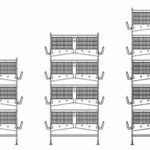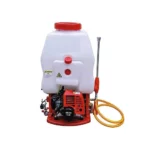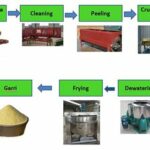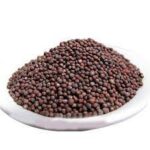Pests are one of the most significant factors that affect productivity and profitability in crop production and this explains the importance of pest control..
On September 18, 2020, Farmer Samson Ogbole, discussed at our online training, on the general steps and recommendations for pest control, prevention and management.
Before we go into the details of the training, meet the facilitator of the training.
Farmer Ogbole Samson, Lead Trainer for Farm lab.
Agriculture for Farmer Samson is more than just food production and zero hunger, it is the foundation for sustainable development, job creation, healthier living, as well as national development.
He believes agriculture must adopt the business mindset, technology, automation, precision agriculture, data science and be climate-smart.
Farmer Samson has devoted his time and resources to building modern farms exploring the latest technologies for agriculture, and sharing and training others to adopt “the modern agriculture” to ensure that together, we can use agriculture as a tool to build the nation we so desire.
He believes “food production should not be seasonal because hunger is not seasonal”.
Farmer Samson has a B.Sc. Biochemistry Igbinedion University; M. Sc. Biochemistry, Ibadan, and a Biochemistry PhD candidate, Federal University of Agriculture, Abeokuta. Other certificates include Disruptive strategy from Harvard Business School, Boston USA, Biotechnology from Federal University of Agriculture, Abeokuta, Introduction to Food and Nutrition from Stanford University, Introduction to population health from The University of Manchester, Greening the Economy from Lund University Sweden, Sustainable Agriculture for the year 2050 from Wageningen Netherland, Agroecology and Sustainable Agriculture from The University of Western Australia, and Public Health from University at Albany. He is a postgraduate student of Machine Learning and Artificial Intelligence at The University of Texas at Austin, USA.
Farmer Samson is a two-time TEDx speaker and a one-time TED speaker; recognized amongst the top 7 innovators in Africa in the year 2018 by CNN Africa and by EFCC as one of the young and legitimate innovative minds in the year 2018. In 2019, he was named top 500 in food technopreneurs by Forward Fooding. He was part of the Lagos Farmers’ Team who met and discussed with all gubernatorial aspirants for the 2019 elections to draw a road map for agriculture. He was also a part of the documentary – “Swallow – food security in Nigeria’s changing climate”. Farmer Samson’s creativity and entrepreneurial drive have had him featured on BBC, CNN, Reuters TV, Channels TV and many others, featured on every major news tabloid in Nigeria, and many more.
Farmer Samson discussed the General Farm Pest Control and Management, and here is the summary of the training:
Introduction
The major goal of agriculture worldwide is to produce sufficient food for the ever-growing population, to generate income for the farmers, and also to boost the Gross Domestic Product (GDP).
Generally, the success of agriculture should be gauged from:
- Sufficient food for the growing population
- Farmers being able to make enough income, not just sustainable income and living just above the poverty line
- Enough money generated for the farmers and from the populace in the form of food production to boost the Gross Domestic Product (GDP) of the nation
In every nation, especially the developing nation, most of the farmers are generally smallholder farmers. Also, you will realize that worldwide, pests account for about 36% of the total yield being lost. Because pest management is not only on the field but also during post-harvest. For instance, you could have 36% potential loss in the field and another 14% potential loss in storage. So, in total it means, to pest alone you can lose as much as 50% of the product or the potential yield.
So, the question is, how then do we control pest?
It’s also important to know that pest is not unique to just Africa. That is, it is not an African phenomenon, neither is it a Nigerian thing. Pest is a global epidemic. It’s not something that is just localized for one nation or one state or one continent. There have been issues of pest in the time past from nation to nation..
For example, in North America, there was a time they had the Colorado Potato Beetle known as the Leptinotarsa decimlineata. They’ve had that and it took years to battle. In South-East Asia, they had the Brown Planthopper, which affects mainly Rice. For us in Africa, we’ve had the Larger Grain Borer, that is the Prostephanus truncatus affecting Maize. In the Pacific Islands, they’ve had the Rhinoceros Beetles. We’ve had the one for cotton also in Nicaragua, Egypt. So, a pest is not just a thing that affects Africa.
From the onset of the development of agriculture, from the good olden days where men used to pick fruits and move from fruit collector and hunter to crop producers, pests have always been the norm.
Different Areas in Pest Control and Management
There are four different areas in pest management. These include;
- Pest Spectrum: For instance, if you are a farmer in Ogun State, Abeokuta, the kind of pest that you are likely to see might be different from somebody in Kaduna. So, what are the pest spectrum? What is the current knowledge available for specific pest? Which area of pest management are we most deficient in the knowledge we need to know? Where should effort be focused to manage certain pest?
- Pest Management Technology: Do we have the basic technology to solve the most immediate pest problem? What are the consequences of using such technology? Then, are these technologies adequate to solve the pest problem? Or are they just inevitable so that crops will still be destroyed?
- Integrated Pest Management: Can the available technologies be integrated? Is there any potential to integrate technology for sustainability? What are we missing in integrating the technologies? Can we adapt technology developed elsewhere to suit our local conditions?
- Pest Management Resources: Are the resources for pest management available and adequate? Can we make use of the available resources for greater impact?
Before looking into the impediments to pest management, we should define that pest will be any biological entity capable of causing economic loss on crops. So, either it is affecting the seed you are going to plant or affecting the plant that is growing or affecting the products that you have stored. Either way, we call them pests.

Impediments to Pest Control and Management
Ignorance
One of the major issues we have today with pest management is ignorance. You will realize that especially in Africa, we do not have particular pest organisms and their associated parasites and predators. We do not even know what organisms are present, what does what, what their parasites are, what their predators are.
You might be asking why is there even anything like pest at all. Remember that farming is done in a place that naturally had a basic ecosystem. Whatever plant you are going to be bringing into a place, the ecosystem is not going to change at once. The ecosystem tries to fight back. And at times you will realize that there might already be some pest in that area that are not suitable for the plant you are bringing in. So, there is a need for us to deal with ignorance.
Pest Resistance, Resurgence, and Outbreak

The second major issue that we have had over time with pest management has been either pest resistance, resurgence, and at times a secondary pest outbreak. What do we mean by pest resistance? For instance, you have been able to get away to combat either by using some organic materials or by using a synthetic material. Now, you will realize that if you are not careful, it will get to a time when those pests will become resistant to whatever it is you are using on them. And if you are not careful, there could be a resurgence where there is a bigger growth. In other cases, there could be what we call a secondary pest outbreak.
For example, there is the White Wax Scale, which is Eligascadia destructor that affects mainly Citrus plants in the southern part of Africa. So, what you have is at times, you have secondary pest and secondary pest at times could occur because as you are trying to destroy your main primary pest. Hence, you unknowingly make the place conducive for predators that can attack your primary pest and those predators become also a bigger issue for the plant you have. That could happen and is in itself is a major issue.
It is an issue is because when a pest becomes resistant to a chemical, whatever the active ingredient it is in that chemical. When we say the active ingredient, what we mean is a particular active substance in that chemical that does the main job. And once a pest can develop resistance to that active ingredient, there is no way to bring about susceptibility again for that active ingredient in the insect. And that becomes an issue, which is why people start going for much more, higher graded dosage or active chemicals.
Therefore, if a pest becomes resistant to one chemical or a particular percentage of the active ingredient, the only way that kind of chemical can work is to increase the concentration or switch to another type with a different active ingredient that can still combat that disease.
Environmental Contamination
This is a big challenge for farmers who tend to use organochlorides or chemicals that have broad-spectrum activities. Yes, you have been able to kill the insect, but what is the impact of that insect decaying in that environment? What is the impact of that chemical touching the environment where your plants are growing? Does it have a high active ingredient that can even go ahead and contaminate your groundwater? Or, does it have even an active ingredient that when it gets into your soil, can bind to your substrate you are using for growing, such that your substrate’s CEC (that’s the Cation Exchange Capacity) is affected and is unable to bind properly to your nutrient?
This will automatically increase the use of nutrient because, every time you apply nutrient, it is not able to hold on for so long. In some cases, it could even affect the part that the plant can pick it up. And in the worst cases, it could even go ahead and affects the consumer.
Introducing Exotic and Endemic Pests
So, number four is increasing pest problems by introducing exotic and endemic pests. For example, we are bringing in plants say from Nairobi to Nigeria or from India to Nigeria. If screening is not properly done for those plants, you will realize that you can introduce a pest of a foreign nation into your own country. This is why you realize that when you want to import plants, they will ask you to get a certification of different types to ensure that the plant is clean.
So, quarantine measures in the future are very important to protect the biogeographical areas. Not just in individual countries. So, for example, an exotic pest that gets into a place like the Benin Republic, Togo, Ghana, can easily sweep into Nigeria, because of our close ties. So, it’s not just quarantining for your nation but to ensure that nations sharing major similar boundaries work on ensuring they have similar standards and regulations, rules for quarantining and for allowing live (unprocessed) plants or fresh fruits and vegetables from moving from one territory into another.
Pesticides Treadmill
When pesticides were first discovered in the 70s, 60s, and 50s, these pesticides were super cheap. However, you will realize that these pesticides were very active then because the pests were super-susceptible. But over time these chemicals were also relatively cheap. And over time, as the pest became much more resistant, there was always a need to produce a higher dosage of these chemicals, much more potent.
Now, the issue with this is, the more you try to make much more potent, harsher forms of these chemicals and all of that, what this brings about is what we call a pesticides spiral or a pesticide treadmill, which can result in a whole lot of environmental backlashes, pollution, secondary pest outbreaks, losing control of your biocontrol and a whole lot of things can happen.
Therefore, before you introduce any chemical, be sure of your need for it. Do you have an alternative method to get this done? If yes, why not run with that instead.
So, pesticide treadmill is a big issue to date because, once you start using one chemical, you have to increase the dosage, increase frequency over time and all of this has adverse effects.
Future Development of Pest Control and Management Techniques
These are some of the things we can look forward to as we move into the future to overcome the impediments of pest control and management. That is, some of the major things that we would try to do as we enter into the future are how can we have technologies that mitigate against these issues while at the same time solve the issues of pest.
Some of these technological areas in development include;
Pheromones
Pheromones have various functions in insects. They differ from one insect to another. A pheromone is like a smell from specific insects and they have different functions. For example, in locust, how do locust know how to move together? How do they know how to run and move into a field together? It is because when they all produce their pheromones, they can smell where other locusts are going to join.
Now, why is it that you hardly see crickets all moving together in one place? It’s because crickets can also use their pheromones to move apart so they don’t all get located in one place. Now, in this case, they can use it for cohesion, to work together as one. However, in the case of Armyworm, which affects maize a lot in Nigeria, their pheromones help them in sex, to know when they should come together for mating. Also in locust, pheromones helps in their growth regulation.

How then do we use pheromones? For example, we use sex pheromones to attract the opposite sex in traps. In armyworms, they are used in early warning systems to indicate the severity of the forthcoming armyworm outbreak, so that you can mitigate against it before it happens. You can also use aggregation pheromones to bring different individuals for mating, feeding or to defend a colony.
In using pheromones, and the pheromones are produced in the lab, you must be able to use them in their right concentration, right time, and the right distance. So, you know that armyworms are supposed to come to your maize farm, and they are going to produce these pheromones to come to your maize farm. You can now strategically go and place these pheromones in a different location where there is no maize. So, instead of all the armyworms to come to your farm to cause havoc, they can move to another location and they get there and realize there is no maize. But before they get back to your farm, they are starved to death. Right now, there is a development on the use of pheromones.
Biopesticides
A second major part is what we call Biopesticides. We have different types of biopesticides made from plant alkaloids, and most of them are already in use for pest control. One of the most successful ones is pyrethrin. But the challenge with that is, pyrethrin is not stable in light, so, we use that one more for storage.
Biological Control
Here, you can use specific parasites, predators or pathogens to manage pest on the farm or in your storage. So, this is where knowledge comes in play, remember we talked about ignorance at the beginning. If I know what could affect your plant, you can get a predator to eat up whatever pest that is supposed to eat my plant. And that goes a long way.
For example, we have what we call pathogenic microbes, where you bring in some specifically bred viruses, bacteria, protozoan, fungi as a way to deal with pests. It’s either they are eating up your pest or they are infecting the pest. So, you can have microbes that infect the pest, kills the pest, on the farm. So, that is a whole different area under development.
Hormone Mimics
This is used a lot again in the field like your maize farm, where we bring hormones into the farm. You just spray them like you are spraying an insecticide. Now, one of the major hormone mimics that is used today is what we call the juvenile hormone. Now, what the juvenile hormone does is control the process of the maturation of that pest from the larva stage to the adult stage. Because of that, that larvae stage can stay so long that the animal dies down in that form. So, it delays their maturation. However, if it is an insect that is the most destructive at the larvae stage, then this might not be the best.
Recombinant DNA Technology
This is already being worked on, and with it, pests can be better managed in the future. Although it has a whole lot of controversies as to what would be the aftermath effect.
There is also cloning to produce much more resistant crops, and this could be through hybrids. That is, creating much more resistant hybrids to pest or producing the bio-positive selection, the activation of chemical defence in a plant. This is very common for example in a plant called Quill. Also, breeding for chemical host resistance and Legislation in pest management.
Integrated Pest Control and Management
As a farmer or as an intending farmer, before you buy that land and commit to what you intend to grow, try to understand the pathogenic history of that place. Look at the type of plant, do an analysis. Understand, what the density-dependent factors, spatial distribution, and behavioural patterns of these pests. That is, know at what density they do become problematic.
One, you need to know if the insects are present, how they begin their outbreak, and the signs to look out for. Is it when the weather gets warm, when the temperature drops, or when the rain comes? Is it when the place is super dry? Because by understanding this, you can even control the outbreak of insects without using chemicals. For example. If I know this particular insect will come if everywhere is super dry and then humidity falls to less than 40. It means all I need to do is to install sprinklers on the farm to keep the humidity above 40 and the outbreak will not happen. So, what is the mode of operation of these insects? You need to understand these.
Two, what is the damage potential if this outbreak should occur? This will help you know which is better between the cost of preventing the damage versus the actual damage. Then, there is also the need for appropriate timing to have control operations. You don’t want to apply whatever you need to apply before there is even an outbreak such that it is no longer effective.
Also, seek information. Find out, what you need to know What are the latest things you need to be aware of? What is the latest? The latest from the scientist, the latest from the extension workers? What are other farmers getting? What are the issues they are facing?
Ecological Approach to Pest Control and Management
- Know the ecology of that environment and understand the principles best suited for managing that pest. Work to have biodiversity because when you are growing a single crop, there is the propensity or the probability to keep increasing the pest density in that area, because you are growing a single crop. So, try to go for biodiversity so that, that way you might even have other organisms that might feed on your pest. Ensure the environment is healthy enough for the plants that you are growing.
- Reduce disturbance to the soil and non-crop vegetation of your farm. It helps a lot.
- Minimize your off-farm input. Very important. As you are selecting your seeds, your graftings and all of that, look for resistant varieties to whatever pest is predominant in that area.
- If you are going to be growing in an area, try as much as you can to decrease the natural or seminatural habitat. Then, enhance the natural enemies and create multiple enemies for the pest. It’s also important. Reduce excess sources of Nitrogen. You want to reduce nitrogen content in that area, such that what is available is just what the plant needs.
- Then, if you must use pesticides, as much as you can, look for targeted pesticides that are meant specifically for that insect.
Questions
Question: “ In using pheromones to attract specific insects to another location, is it not possible for the pheromones to be attracted and become pests of the other crop? “- Bim Bim
Response: If for example, you are using pheromones to move armyworms because you know the host for armyworm is maize, and your friend, who is about 5 or 6 kilometres away from your farm, has cassava. If you spray those hormones on your friend’s farm, you will realize that these armyworms will leave your farm and move to the other farm.
Question: “Thanks for the wonderful session…. please kindly illuminate me on pest control in a feed mill. Especially when it comes to a rat infestation. The best way to control it, when knowing full well that it is unprofessional to use rat poison, so what the best way to fumigate a feed mill…. thanks.” – Deola
Response: First and foremost, you need to try to ensure you remove hidden corners. Rats are animals that love hidden corners. So, try to ensure there are no hiding corners, there are no dark places, there are no unseen places where they can hide. Then, keep what it is called rats barns to trap them.
Question: “In using Pheromones to divert the attention of pest out of the main planting environment where they can cause damage to plants, what if the pests present in that environment are more than one, how do we go about it.?”- Olaniran
Response. Even if they are more than one, they all have their pheromones, so you apply to them. The important thing is that you are trying to move all of them away from one location to another if that is what works best for what you want to do.

Question: “How do we know what the ecosystem of the land we are about to use is like?”- Cronywildfire
Response: To know the ecosystem of the land you want to use, do a test. Get a soil scientist, the pathologist, they can help you. In running the test, they can test the area and know what had been the predominant pest in the area.
Question: “Will you say companion planting is a way to keep pests in check? If yes how effective is it for pest control?” – Bim Bim
Response: In companion planting, you are planting a crop that can work with another crop that confirms resistance, immunity or protection from pest. So, yes, companion planting is also a very good and effective method of Pest Control, if properly done. You need to be able to fully understand the ecology of both plants.
Question: “What is the accepted questions that one may consider if preparing to release new pesticides?” – Manfred Chukwudi
Response: If you are preparing to release a new pesticide in an area, understand the rules and regulation of that area and the interaction of your pesticide with the environment so that you can defend it.
Question: “Before, applying chemical products such as insecticide and fungicide to your plants, what are the things you put into consideration?” – Olaniran
Response: Know your best option and what is the impact. Are there chemicals deposited inside the plant? Then, consider the impact on the environment on your health as a farmer.














One thought on “Pest Control and Management in Agriculture”
Wonderful it’s a great presentation, simple language for to ease understanding of target audience. Would appreciate learning more about pest control management and agribusiness in general under your mentorship. Well done